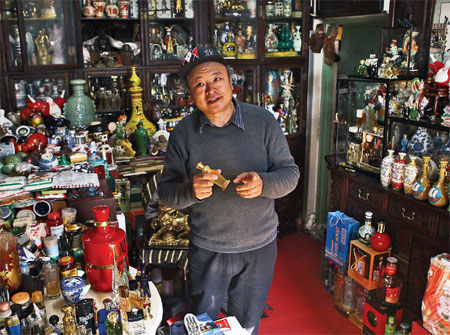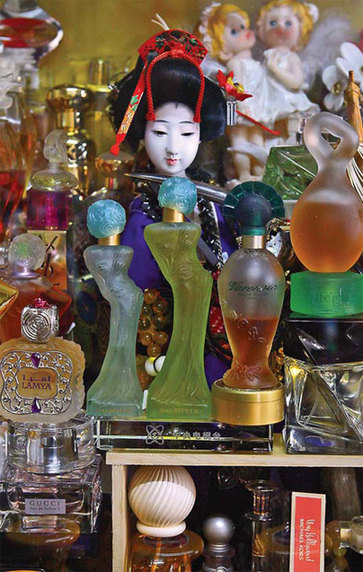Bottled up passion
Updated: 2012-01-31 08:00
By Han Bingbin (China Daily)
|
|||||||||||
|
Cui Shaosong at his Beijing apartment, which houses a collection of more than 5,000 perfume bottles. Photos By Zou Hong / China Daily |
A perfume container collector believes love and fate fuel his obsession. Han Bingbin reports.
Perfume bottle collector Cui Shaosong repeatedly apologizes for the state of his apartment, saying it's not suitable for visitors. The dwelling, which is less than 40 square meters, is filled with fragrances and crammed with intricately designed cabinets. These warehouse more than 5,000 perfume bottles of about 200 brands - old and new, empty and full. The 55-year-old's bed is set in the middle of the elegant mess. Cui says his collection cost him nearly 1 million yuan ($159,000), with which he could have purchased a larger apartment. He has responded to his wife's complaints over the years by saying: "Who can refuse an unexpected and happy fate?"
His perfume bottle collection started 30 years ago, when the then liquor collector asked a friend for three bottles but forgot to mention he meant liquor containers and was instead given perfume bottles.
Two were beautiful bottles of Mitsouko and Shalimar, both by Guerlain. They outshone his liquor bottles, and his passion for pretty perfume containers was born.
The latest addition is a silver bottle of Marc Jacobs Bang, which was released in 2011. The oldest bottle is from the 1890s.
His greatest source of pride is a pair of crystal bottles from a Japanese brand called Seven and a Half Drops.
|
Part of Cui's perfume bottle collection. |
The brand is so named because the small bottle contains only seven and a half drops of liquid that has changed from light yellow to dark red over the decades. The bottles were produced in 1926 to celebrate the first Showa Year, and each have a large pyramidal cap inside on which the likeness of the Showa Tower of Nara is sculpted.
One of the bottles was a gift from the owner of a bottle museum in Japan.
Cui intended to donate some of his finds to the museum when he visited in 1990.
The owner politely refused and gave him the precious item because he was the first Chinese visitor.
Cui is a devout Buddhist, who believes his obsession is the product of fate.
He believes it was destiny that he came across a larger but otherwise identical bottle at a Tokyo flea market, so he could create a pair.
Cui says this event was also related to the philosophical concept espoused by the museum's owner: "The bottles are like a huge family, and a collector's responsibility is to reunite them one way or another."
This has inspired him to try to collect entire series. He has more than 200 bottles from the Christian Dior Tendre Poison series, for instance.
The collector has befriended perfume dealers who offer him samples, discontinued varieties, and commemorative and limited editions at discounts or for free. He sometimes trades liquors for perfumes.
Cui doesn't wear perfume or care about fashion, which makes his current collection different from his liquor bottle collection, as he was a tipple connoisseur.
He knew little about perfume and only cared about the containers' appearances.
"It's the bottles' attractiveness that leads people to buy perfume in the first place," he says.
It was only a few years ago that the former archeology student started digging deeply to learn more about perfumes.
His room is scattered with international shopping catalogues, fashion magazines and brand biographies.
He enjoys talking about the production of the world's first perfume bottles and the differences between plant and musk fragrances. But his pronunciation sometimes betrays how new he is to the subject.
His decision to learn about perfume, he says, has been inspired by an interest to discuss his collection.
Cui has staged annual exhibitions at Beijing's antiques hub, Panjiayuan, since 2009.
He recalls displaying 110 bottles in a 1-meter display area, although he knew from a shop window-display design class that the upper limit is nine.
He has won fans through the exhibitions, who defend him online when others post photos of his collection and claim it's theirs.
He is also frequently approached by businesspeople from as far away as Hong Kong, who are interested in buying his collection. Through them, he has come to realize it has increased in value. His bottle of Clive Christian with a gold-colored cap, for example, sells for up to 80,000 euros ($105,161).
Cui refuses to sell any of his bottles, although he realizes their accumulation will eventually become burdensome. He instead plans to donate them to people who like them, he says.
"Some people create beautiful things, and others use them," Cui says.
"If beautiful things remain unbroken, they can be passed along to next person, the next 10 people or even the next 100. This is the procession of beauty."
Today's Top News
Rescuers race against time for quake victims
Telecom workers restore links
Coal mine blast kills 18 in Jilin
Intl scholarship puts China on the map
More bird flu patients discharged
Gold loses sheen, but still a safe bet
US 'turns blind eye to human rights'
Telecom workers restore links
Hot Topics
Lunar probe , China growth forecasts, Emission rules get tougher, China seen through 'colored lens', International board,
Editor's Picks

|

|

|

|

|

|







